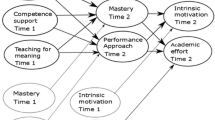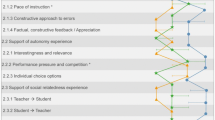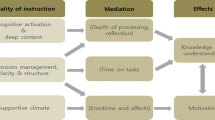Abstract
Teaching effectiveness has often been described from a variable-centered perspective according to instructional, organizational, and emotional teaching characteristics and their prediction of students’ outcomes. Adopting a person-centered approach, the present study analyzed how multiple variables of teaching quality co-occur simultaneously within teachers and how these teaching profiles are related to students’ development in achievement and enjoyment. Data from 3483 secondary students and their 155 mathematics teachers were analyzed at two measurement points. A latent profile analysis identified high-, medium-, and low-quality teaching profiles. Multilevel analyses revealed that the high-quality profile—as compared to the medium-quality profile—was positively related to achievement gains, whereas no significant difference was found for students’ development in enjoyment. The findings reveal quantitative instead of qualitative teaching profiles and challenge the implicit assumption the higher the better. In particular, effective teachers may not need to display the highest levels in all teaching aspects. Instead, different thresholds for teaching effectiveness may apply for students’ achievement gains and emotional development, respectively.



Similar content being viewed by others
Notes
Based on a rotational design, on average, 55% of the students in each class rated their teachers’ teaching quality. The other 45% of the students completed different questionnaires.
The reanalysis of LPA without the subscale “respectful treatments of students” showed the same pattern of profiles. Therefore, we decided to keep the scale in the analyses.
Alpha values for students’ mathematics achievement in grade 9 and grade 10 are based on a student sample that also includes classes that participated at only one measurement point only.
References
Bauer, D. J., & Shanahan, M. J. (2007). Modeling complex interactions: person-centered and variable-centered approaches. In T. D. Little, J. A. Bovaird, & N. A. Card (Eds.), Modeling contextual effects in longitudinal studies (pp. 255–283). Mahwah: Lawrence Erlbaum Associates.
Baumert, J., Kunter, M., Blum, W., Brunner, M., Voss, T., Jordan, A., et al. (2010). Teachers’ mathematical knowledge, cognitive activation in the classroom and student progress. American Educational Research Journal, 47, 133–180. https://doi.org/10.3102/0002831209345157.
Bennett, A. A., Gabriel, A. S., Calderwood, C., Dahling, J. J., & Trougakos, J. P. (2016). Better together? Examining profiles of employee recovery experiences. Journal of Applied Psychology, 101, 1635–1654. https://doi.org/10.1037/apl0000157.
Blazar, D., & Kraft, M. (2017). Teacher and teaching effects on students’ attitudes and behaviors. Educational Evaluation and Policy Analysis, 39, 146–170. https://doi.org/10.3102/0162373716670260.
Brophy, J. (1986). Teacher influences on student achievement. American Psychologist, 41, 1069–1077. https://doi.org/10.1037//0003-066x.41.10.1069.
Bryk, A. S., & Raudenbush, S. W. (1987). Application of hierarchical linear models to assessing change. Psychological Bulletin, 101, 147–158. https://doi.org/10.1037/0033-2909.101.1.147.
Burke, M. J., Finkelstein, L. M., & Dusig, M. S. (1999). On average deviation indices for estimating interrater agreement. Organizational Research Methods, 2, 49–68. https://doi.org/10.1177/109442819921004.
Celeux, G., & Soromenho, G. (1996). An entropy criterion for assessing the number of clusters in a mixture model. Journal of Classification, 13, 195–212. https://doi.org/10.1007/BF01246098.
Cohen, J. (2015). Challenges in identifying high-leverage practices. Teachers College Record, 117, 1–41.
Collins, L. M., & Lanza, S. T. (2010). Latent class and latent transition analysis—with applications in the social, behavioral, and health sciences. Hoboken: Wiley.
Curby, T. W., LoCasale-Crouch, Konold, R, T., Pianta, R. C., Howes, C., Burchinal, M., et al. (2009). The relations of observed pre-k classroom quality profiles to children’s achievement and social competence. Early Education and Development, 20, 346–372. https://doi.org/10.1080/10409280802581284.
Ehmke, T., Blum, W., Neubrand, M., Jordan, A., & Ulfig, F. (2006). Wie verändert sich die mathematische Kompetenz von der neunten zur zehnten Klassenstufe [How does mathematical competence change between grade nine and ten?]. In M. Prenzel, J. Baumert, W. Blum, R. Lehmann, D. Leutner, M. Neubrand, R. Pekrun, J. Rost, & U. Schiefele (Eds.), PISA 2003: Untersuchungen zur Kompetenzentwicklung im Verlauf eines Schuljahres (pp. 63–86). Münster: Waxmann.
Evertson, C. M., & Weinstein, C. S. (2006). Classroom management as a field of inquiry. In C. M. Evertson & C. S. Weinstein (Eds.), Handbook of classroom management (pp. 3–15). Mahwah: Lawrence Erlbaum Associates.
Fauth, B., Decristan, J., Rieser, S., Klieme, E., & Büttner, G. (2014). Student ratings of teaching quality in primary school: dimensions and prediction of student outcomes. Learning and Instruction, 29, 1–9. https://doi.org/10.1016/j.learninstruc.2013.07.001.
Frenzel, A. C., Pekrun, R., & Goetz, T. (2007). Perceived learning environment and students’ emotional experiences: a multilevel analysis of mathematics classrooms. Learning and Instruction, 17, 478–493. https://doi.org/10.1016/j.learninstruc.2007.09.001.
Frenzel, A. C., Goetz, T., Lüdtke, O., Pekrun, R., & Sutton, R. E. (2009). Emotional transmission in the classroom: exploring the relationship between teacher and student enjoyment. Journal of Educational Psychology, 101, 705–716. https://doi.org/10.1037/a0014695.
Goetz, T., Frenzel, A. C., Pekrun, R., & Hall, N. C. (2006). The domain specificity of academic emotional experiences. The Journal of Experimental Education, 75, 5–29. https://doi.org/10.3200/JEXE.75.1.5-29.
Grossman, P., Loeb, S., Cohen, J., & Wyckoff, J. (2013). Measure for measure: the relationship between measures of instructional practice in middle school English language arts and teachers’ value-added scores. American Journal of Education, 119, 445–470. https://doi.org/10.1086/669901.
Grossman, P., Cohen, J., Ronfeldt, M., & Brown, L. (2014). The test matters: the relationship between classroom observation scores and teacher value added on multiple types of assessment. Educational Researcher, 43(6), 293–303. https://doi.org/10.3102/0013189X14544542.
Halpin, P. F., & Kieffer, M. J. (2015). Describing profiles of instructional practice: a new approach to analyzing classroom observation data. Educational Researcher, 44(5), 263–277. https://doi.org/10.3102/0013189X15590804.
Hamre, B. K., & Pianta, R. C. (2005). Can instructional and emotional support in the first-grade classroom make a difference for children at risk of school failure? Child Development, 76, 949–967. https://doi.org/10.2307/3696607.
Hattie, J. (2009). Visible learning: A synthesis of over 800 meta-analyses relating to achievement. New York: Routledge.
Helmke, A., & Weinert, F. E. (1997). Unterrichtsqualität und Leistungsentwicklung: Ergebnisse aus dem SCHOLASTIK- Projekt [Quality of instruction and development of achievement: results from the SCHOKASTIK project]. In A. Helmke & F. E. Weinert (Eds.), Entwicklung im Grundschulalter (pp. 223–258). Weinheim: Psychologie Verlags Union.
Hill, H. C., Umland, K., Litke, E., & Kapitula, L. R. (2012). Teacher quality and quality teaching: examining the relationship of a teacher assessment to practice. American Journal of Education, 118, 489–519. https://doi.org/10.1086/666380.
Holzberger, D., Philipp, A., & Kunter, M. (2013). How teachers’ self-efficacy is related to instructional quality: A longitudinal analysis. Journal of Educational Psychology, 105, 774–786. https://doi.org/10.1037/a0032198.
Keeley, J. W., English, T., Irons, J., & Henslee, A. M. (2013). Investigating halo and ceiling effects in student evaluations of instruction. Educational and Psychological Measurement, 73, 440–457. https://doi.org/10.1177/0013164412475300.
Klieme, E., Schümer, G., & Knoll, S. (2001). Mathematikunterricht der Sekundarstufe I: "Aufgabenkultur" und Unterrichtsgestaltung im internationalen Vergleich [Mathematics instruction at lower secondary level: “task culture” and quality of instruction]. In J. Baumert & E. Klieme (Eds.), TIMSS - Impulse für Schule und Unterricht. Forschungsbefunde, Reforminitiativen, Praxisberichte und Video-Dokumente (pp. 43–57). Bonn: Bundesministerium für Bildung und Forschung.
Kunter, M., & Baumert, J. (2006). Who is the expert? Construct and criteria validity of student and teacher ratings of instruction. Learning Environments Research, 9, 231–251. https://doi.org/10.1007/s10984-006-9015-7.
Kunter, M., Tsai, Y.-M., Klusmann, U., Brunner, M., Krauss, S., & Baumert, J. (2008). Students’ and mathematics teachers’ perceptions of teacher enthusiasm and instruction. Learning and Instruction, 18, 468–482. https://doi.org/10.1016/j.learninstruc.2008.06.008.
Kunter, M., Frenzel, A., Nagy, G., Baumert, J., & Pekrun, R. (2011). Teacher enthusiasm: Dimensionality and context specificity. Contemporary Educational Psychology, 36, 289–301. https://doi.org/10.1016/j.cedpsych.2011.07.001.
Kunter, M., Baumert, J., Blum, W., Klusmann, U., Krauss, S., & Neubrand, M. (2013a). Cognitive activation in the mathematics classroom and professional competence of teachers. Results from the COACTIV project. New York: Springer.
Kunter, M., Klusmann, U., Baumert, J., Richter, D., Voss, T., & Hachfeld, A. (2013b). Professional competence of teachers: effects on instructional quality and student development. Journal of Educational Psychology, 105, 805–820. https://doi.org/10.1037/a0032583.
LeBreton, J. M., & Senter, J. L. (2008). Answers to 20 questions about interrater reliability and interrater agreement. Organizational Research Methods, 11, 815–852. https://doi.org/10.1177/1094428106296642.
Lo, Y., Mendell, N. R., & Rubin, D. B. (2001). Testing the number of components in a normal mixture. Biometrika, 88, 767–778. https://doi.org/10.1093/biomet/88.3.767.
LoCasale-Crouch, J., Konold, T., Pianta, R. C., Howes, C., Burchinal, M., Bryant, D., et al. (2007). Observed classroom quality profiles in state-funded pre-kindergarten programs and associations with teacher, program, and classroom characteristics. Early Childhood Research Quarterly, 22, 3–17. https://doi.org/10.1016/j.ecresq.2006.05.001.
Lüdtke, O., Trautwein, U., Kunter, M., & Baumert, J. (2006). Reliability and agreement of student ratings of the classroom environment: a reanalysis of TIMSS data. Learning Environments Research, 9, 215–230. https://doi.org/10.1007/s10984-006-9014-8.
Molenaar, P. C. M., & Campbell, C. G. (2009). The new person-specific paradigm in psychology. Current Directions in Psychology, 18, 112–117. https://doi.org/10.1111/j.1467-8721.2009.01619.x.
Morin, A. J. S., Morizot, J., Boudrias, J.-S., & Madore, I. (2011). A multifoci person-centered perspective on workplace affective commitment: a latent profile/factor mixture analysis. Organizational Research Methods, 14, 58–90. https://doi.org/10.1177/1094428109356476.
Muthén, L. K., & Muthén, B. O. (2015). Mplus user’s guide. Seventh edition. Los Angeles: Muthén & Muthén.
Nie, Y., & Lau, S. (2009). Complementary roles of care and behavioral control in classroom management: the self-determination theory perspective. Contemporary Educational Psychology, 34, 185–194. https://doi.org/10.1016/j.cedpsych.2009.03.001.
Nisbett, R. E., & Wilson, T. D. (1977). The halo effect: evidence for unconscious alteration of judgments. Journal of Personality and Social Psychology, 35, 250–256. https://doi.org/10.1037//0022-3514.35.4.250.
Nylund, K. L., Asparouhov, T., & Muthén, B. O. (2007). Deciding on the number of classes in latent class analysis and growth mixture modeling: a Monte Carlo simulation study. Structural Equation Modeling, 14, 535–569. https://doi.org/10.1080/10705510701575396.
Organization for Economic Cooperation and Development. (2004). Learning for tomorrow’s world: First results from PISA 2003. Paris.
Oser, F. K., & Baeriswyl, F. J. (2001). Choreographics of teaching: bridging instruction to learning. In V. Richardson (Ed.), Handbook of research on teaching (4th ed., pp. 1031–1065). Washington, DC: American Educational Research Association.
Pakarinen, E., Kiuru, N., Lerkkanen, M.-K., Poikkeus, A.-M., Siekkinen, M., & Nurmi, J.-E. (2010). Classroom organization and teacher stress predict learning motivation in kindergarten children. European Journal of Psychology of Education, 25, 281–300. https://doi.org/10.1007/s10212-010-0025-6.
Pastor, D. A., Barron, K. E., Miller, B. J., & Davis, S. L. (2007). A latent profile analysis of college students’ achievement goal orientation. Contemporary Educational Psychology, 32, 8–47. https://doi.org/10.1016/j.cedpsych.2006.10.003.
Patrick, H., Ryan, A. M., & Kaplan, A. (2007). Early adolescents’ perceptions of the classroom social environment, motivational beliefs, and engagement. Journal of Educational Psychology, 99, 83–98. https://doi.org/10.1037/0022-0663.99.1.83.
Pekrun, R. (2006). The control-value theory of achievement emotions: Assumptions, corollaries, and implications for educational research and practice. Educational Psychology Review, 18, 315–341. https://doi.org/10.1007/s10648-006-9029-9.
Pekrun, R., Götz, T., Jullien, S., Frenzel, A. C., vom Hofe, R., & Blum, W. (2003). Skalenhandbuch PALMA (Projekt zur Analyse der Leistungsentwicklung in Mathematik) [Codebook for the PALMA study (Project for the analysis of learning and achievement in mathematics)]. Germany: Department of Psychology: University of Munich.
Pianta, R. C., & Hamre, B. K. (2009). Conceptualization, measurement, and improvement of classroom processes: standardized observation can leverage capacity. Educational Researcher, 38, 109–119. https://doi.org/10.3102/0013189X09332374.
Pianta, R. C., La Paro, K. M., & Hamre, B. K. (2008). Classroom assessment scoring system. Baltimore: Paul H. Brookes.
Pianta, R. C., Hamre, B. K., & Allen, J. P. (2012). Teacher-student relationships and engagement: conceptualizing, measuring, and improving the capacity of classroom interactions. In S. L. Christenson, A. L. Reschly, & C. Wylie (Eds.), Handbook of research on student engagement (pp. 365–386). Boston: Springer.
Praetorius, A.-K., Klieme, E., Herbert, B., & Pinger, P. (2018). Generic dimensions of teaching quality: the German framework of Three Basic Dimensions. ZDM Mathematics Education, 50, 407–426. https://doi.org/10.1007/s11858-018-0918-4.
Reyes, M. R., Brackett, M. A., Rivers, S. E., White, M., & Salovey, P. (2012). Classroom emotional climate, student engagement, and academic achievement. Journal of Educational Psychology, 104, 700–712. https://doi.org/10.1037/a0027268.
Rost, J. (1990). Rasch models in latent classes: an integration of two approaches to item analysis. Applied Psychological Measurement, 14, 271–282. https://doi.org/10.1177/014662169001400305.
Salminen, J., Lerkkanen, M.-K., Poikkeus, A.-M., Pakarinen, E., Siekkinen, M., Hännikäinen, M., et al. (2012). Observed classroom quality profiles in kindergarten classrooms in Finland. Early Education and Development, 23, 654–677. https://doi.org/10.1080/10409289.2011.574267.
Salminen, J., Pakarinen, E., Poikkeus, A.-M., & Lerkkanen, M.-K. (2017). Development of pre-academic skills and motivation in kindergarten: a subgroup analysis between classroom quality profiles. Research Papers in Education, 0(0), 1–29. https://doi.org/10.1080/02671522.2017.1353673.
Seidel, T., & Shavelson, R. J. (2007). Teaching effectiveness research in the past decade: the role of theory and research design in disentangling meta-analysis results. Review of Educational Research, 77, 454–499. https://doi.org/10.3102/0034654307310317.
Skinner, E. A., & Belmont, M. J. (1993). Motivation in the classroom: reciprocal effects of teacher behavior and student engagement across the school year. Journal of Educational Psychology, 85, 571–581. https://doi.org/10.1037/0022-0663.85.4.571.
Tein, J.-Y., Coxe, S., & Cham, H. (2013). Statistical power to detect the correct number of classes in latent profile analysis. Structural Equation Modeling, 20, 640–657. https://doi.org/10.1080/10705511.2013.824781.
Vansteenkiste, M., Sierens, E., Goossens, L., Soenens, B., Dochy, F., Mouratidis, A., et al. (2012). Identifying configurations of perceived teacher autonomy support and structure: associations with self-regulated learning, motivation and problem behavior. Learning and Instruction, 22, 431–439. https://doi.org/10.1016/j.learninstruc.2012.04.002.
Vieluf, S., Kaplan, D., Klieme, E., & Bayer, S. (2012). Teaching practices and pedagogical innovation: Evidence from TALIS. Paris: OECD Publishing.
Wagner, W., Göllner, R., Werth, S., Voss, T., Schmitz, B., & Trautwein, U. (2015). Student and teacher ratings of instructional quality: consistency of ratings over time, agreement, and predictive power. Journal of Educational Psychology, 118, 705–721. https://doi.org/10.1037/edu0000075.
Wang, M. C., Haertel, G. D., & Walberg, H. J. (1993). Toward a knowledge base for school learning. Review of Educational Research, 63, 249–194. https://doi.org/10.3102/00346543063003249.
Weinert, F. E., Schrader, F.-W., & Helmke, A. (1989). Quality of instruction and achievement outcomes. International Journal of Educational Research, 13, 895–914. https://doi.org/10.1016/0883-0355(89)90072-4.
Funding
The COACTIV study was supported by the German Research Foundation (BA 1461/2-1 and BA 1461/2-2).
Author information
Authors and Affiliations
Corresponding author
Additional information
Publisher’s note
Springer Nature remains neutral with regard to jurisdictional claims in published maps and institutional affiliations.
Doris Holzberger. TUM School of Education, Technical University of Munich, Arcisstr. 21, 80333 Munich, Germany. E-mail: doris.holzberger@tum.de
Current themes of research:
School conditions and school characteristics. Professional competence of teachers. Instructional quality. Research syntheses and meta-analyses.
Most relevant publications in the field of Psychology of Education:
Holzberger, D., Philipp, A., & Kunter, M. (2016). Ein Blick in die Black-Box: Wie der Zusammenhang von Unterrichtsenthusiasmus und Unterrichtshandeln von angehenden Lehrkräften erklärt werden kann [A glance into the black box: how the relationship between teacher candidates’ enthusiasm for teaching and their instructional behavior can be explained]. Zeitschrift für Entwicklungspsychologie und Pädagogische Psychologie, 48(2), 90–105. doi:10.1026/0049-8637/a000150.
Holzberger, D., Philipp, A., & Kunter, M. (2014). Predicting teachers’ instructional behaviors: the interplay between self-efficacy and intrinsic needs. Contemporary Educational Psychology, 38(2), 100–111. doi:10.1016/j.cedpsych.2014.02.001.
Holzberger, D., Philipp, A., & Kunter, M. (2013). How teachers’ self-efficacy is related to instructional quality: a longitudinal analysis. Journal of Educational Psychology, 105(3), 774–786. doi:10.1037/a0032198.
Anna-Katharina Praetorius. University of Zurich, Freiestrasse 36, 8032 Zürich, Switzerland
Current themes of research:
Instructional quality. Teachers’ diagnostic competence. Teachers’ professional motivation. Ability self-concept. International comparative educational research.
Most relevant publications in the field of Psychology of Education:
Praetorius, A.-K., Lauermann, F., Klassen, R. M., Drexler, K., Nitsche, S., Janke, S., Dickhäuser, O., & Dresel, M. (2017). Longitudinal relations between teaching-related motivations and student-reported teaching quality. Teaching and Teacher Education, 65, 241–254.
Praetorius, A.-K., Drexler, K., Rösch, L., Christophel, E., Heyne, N., Scheunpflug, A., Zeinz, H., & Dresel, M. (2015). Judging students’ self-concepts within 30 seconds? An application of the zero-acquaintance approach to research on teachers’ judgment accuracy. Learning and Individual Differences, 37, 231–236.
Praetorius, A.-K., Pauli, C., Reusser, K., Rakoczy, K., & Klieme, E. (2014). One lesson is all you need? Stability of instructional quality across lessons. Learning and Instruction, 31, 2–12. doi:10.1016/j.learninstruc.2013.12.002.
Tina Seidel. TUM School of Education, Technical University of Munich, Arcisstr. 21, 80333 Munich, Germany
Current themes of research:
Student individual characteristics. Teacher-student interactions in classrooms. Multi-media based tools for teacher education. Research syntheses and meta-analyses.
Most relevant publications in the field of Psychology of Education:
Seidel, T., & Stürmer, K. (2014). Modeling the structure of professional vision in pre-service teachers. American Educational Research Journal, 51(4), 739–771. doi:10.3102/0002831214531321.
Seidel, T., & Shavelson, J.R. (2007). Teaching effectiveness research in the past decade: role of theory and research design in disentangling meta-analysis results. Review of Educational Research, 77(4), 454–499.
Seidel, T., & Prenzel, M. (2006a). Stability of teaching patterns in physics instruction: findings from a video study. Learning and Instruction, 16(3), 228–240.
Mareike Kunter. Goethe University Frankfurt, Theodor-W.-Adorno-Platz 6, 60629 Frankfurt am Main, Germany
Current themes of research:
Professional competence of teachers. Teacher career development. Classroom instruction. Motivation at school.
Most relevant publications in the field of Psychology of Education:
Kunter, M., & Hasselhorn, M. (2016). Children at risk of poor educational outcomes: how educational research can support early identification and improve prevention. Journal of Educational Research Online, 8, 3–6.
Kunter, M., & Holzberger, D. (2014). Loving teaching: research on teachers’ intrinsic orientations. In P. W. Richardson, S. A. Karabenick, & H. M. G. Watt (Eds.), Teacher motivation: theory and practice (pp. 83–99). New York: Routledge.
Kunter, M., Klusmann, U., Baumert, J., Richter, D., Voss, T., & Hachfeld, A. (2013). Professional competence of teachers: effects on instructional quality and student development. Journal of Educational Psychology, 105(3), 805–820. doi:10.1037/a0032583.
Appendix
Appendix
Rights and permissions
About this article
Cite this article
Holzberger, D., Praetorius, AK., Seidel, T. et al. Identifying effective teachers: The relation between teaching profiles and students’ development in achievement and enjoyment. Eur J Psychol Educ 34, 801–823 (2019). https://doi.org/10.1007/s10212-018-00410-8
Received:
Revised:
Accepted:
Published:
Issue Date:
DOI: https://doi.org/10.1007/s10212-018-00410-8




